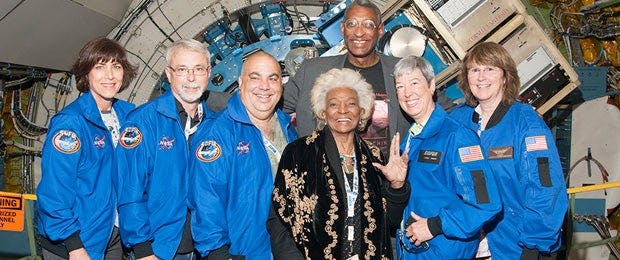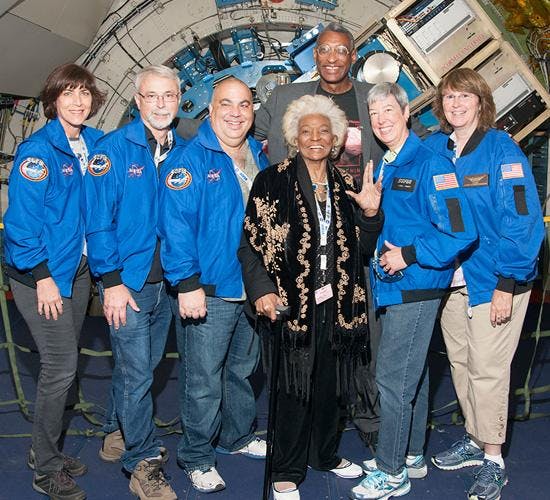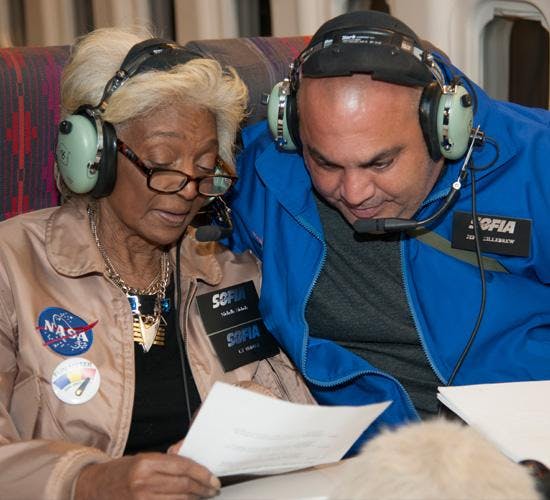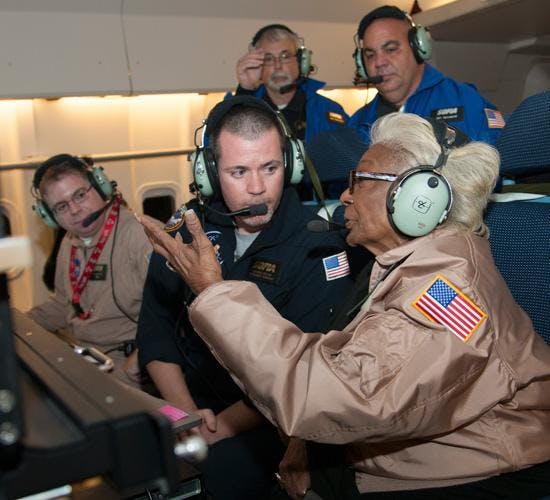Published Aug 3, 2022
Revisiting Nichelle Nichols' NASA/SOFIA Mission
The Star Trek icon joined educators on a science mission!

This article was originally published on October 2, 2015.
On September 30, NASA updated its site with a story about Nichelle Nichols flying along with educators on NASA's September 15th Stratospheric Observatory for Infrared Astronomy (SOFIA) Observatory.
StarTrek.com covered the event in detail at the time, but the NASA story offers additional details, as well as new photos and a video, and so we thought we'd share it with our readers. Behold and enjoy!
On Sept. 15, five educators participating in NASA’s Airborne Astronomy Ambassadors program, boarded the Stratospheric Observatory for Infrared Astronomy (SOFIA), and boldly went where no ambassadors have gone before – into the stratosphere with Nichelle Nichols, actress, cultural icon, and science advocate.

NASA / Carla Thomas
Playing Lt. Uhura on Star Trek, the first major African American female role on TV, Nichols used her role to touch the lives of many people, a responsibility she carried out with purpose by recruiting women and underserved candidates for NASA and science careers. Nichols continued this commitment as she flew on SOFIA, a modified Boeing 747SP jetliner with an infrared telescope on board.“Flying on SOFIA has many parallels to the starship Enterprise,” said Nichols. “We went where no man or woman has gone before, and I think that’s what SOFIA gives us – a tool to study where we want to go in the future. It’s magnificent.”Nichols and science researchers answered questions through social media during her pre-flight training as well as the flight itself, sharing the experience and what she was learning with her worldwide followers. Nichols and the Airborne Astronomy Ambassadors engaged with researchers who were acquiring infrared measurements at 5 to 37 microns – some wavelengths within this range that cannot be seen from ground-based telescopes because of water vapor in Earth’s lower atmosphere.SOFIA’s science team took measurements of the star forming regions W31S (in the constellation Sagittarius), W49A and W51A (both in the constellation Aquila), and W58A (in the constellation Cygnus). The final science investigation for the night was to observe a protostar called Elias 3-18 (in the constellation Taurus) to determine how icy particles in space serve as “carriers” of organic compounds, such as methane, into regions from which planets and stars form.

NASA / Carla Thomas
The Airborne Astronomy Ambassadors is a professional development program for educators, primarily sixth through 12th grade teachers and science center educators, who fly on SOFIA with astronomers, and personally experience the realm of scientific research and the teamwork required to take astronomical observations on board the flying observatory. The educators then share their insights and firsthand accounts of adventures with their classrooms and communities to encourage students to follow their interests in science, technology, engineering and math careers.“Being on the flight with Nichelle Nichols was an incredible capstone to my participation in scientific discovery on SOFIA. The process of research itself is amazing, but the social and educational ramifications that she represents are what sent the whole experience beyond the stratosphere,” said Jeffrey Killebrew, teacher at the New Mexico School for the Blind and Visually Impaired. “Being able to talk with my students and show them a video clip of Nichols talking about how Dr. Martin Luther King Jr. encouraged her to stay with the role of Lt. Uhura, and be that one person to positively illuminate African Americans during that tumultuous time of the late 1960s and early ’70s, is very powerful for my students.”

NASA / Carla Thomas
“It’s interesting to observe how science onboard SOFIA has connected my students with Nichols who has spent the majority of her adult life representing the unrepresented and encouraging the un-encouraged,” continued Killebrew. “It really means a lot to us here.”As the 10-hour science mission neared its conclusion, Nichols took time to film a “shout-out” to students at the New Mexico School for the Blind as well as the visually impaired across the nation, urging them to “live long and prosper.”Ambassadors for the flight included Susan Oltman (Kittredge Magnet School) and April Whitt (Fernbank Science Center), both in Atlanta, Georgia, Jeffery Killebrew (New Mexico School for the Blind and Visually Impaired), and Michael Shinabery (New Mexico Museum of Space History), both in Alamogordo, New Mexico, and Jo Dodds from the Idaho Digital Learning Academy, Twin Falls, Idaho.
Stay tuned to StarTrek.com for more details! And be sure to follow @StarTrek on Facebook, Twitter, and Instagram.

